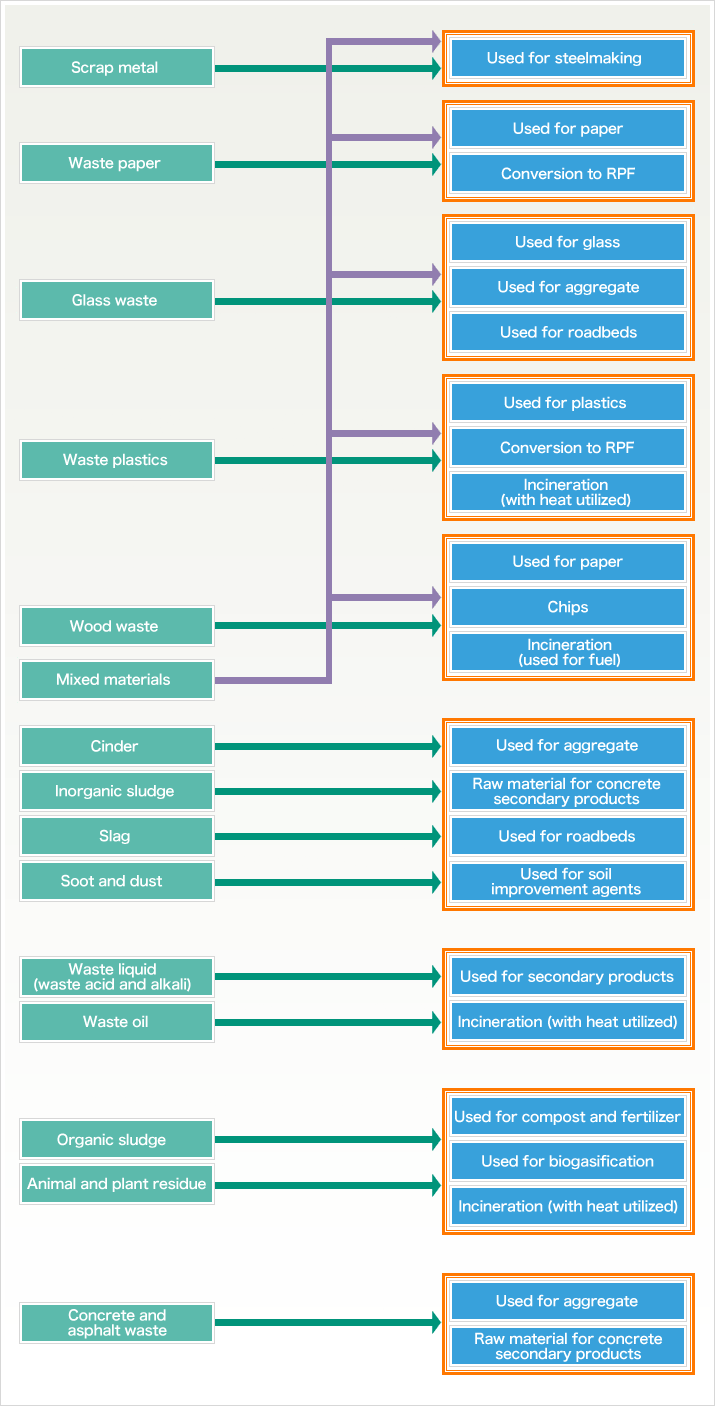Achieving zero emissions―YAMAZEN's recycling solutions
It is considered that zero emissions are based on the suppression of waste and effective circulation of resources in society as a whole. YAMAZEN believes that the construction of a network circle across the borders of industries regardless of their sizes is the most effective way to the formation of a recycling-based society. Therefore, YAMAZEN is focusing on the construction of a broad network without clinging to a view of doing everything in-house or by the YAMAZEN group in order to respond to each customer's request flexibly from a customer-oriented viewpoint.
YAMAZEN's recycling business
YAMAZEN is promoting material recycling centered on the Ueno Eco Center, which has comprehensive processing and recycling facilities that accepts various types of waste, while each YAMAZEN group company is actively developing recycling business.

-
RPF recycling
YAMAZEN compresses and reduces the volume of waste plastics and paper waste to manufacture refuse paper and plastic fuel (RPF). The RPF is of stable quality, which allows ease of calorie control with formulation change, and ensures ease of handling. Therefore, it is used as fuel mainly for paper mills and steel plants. Furthermore, the use of RPF can reduce the consumption of fossil fuel, such as coal, thus making it possible to suppress the amount of CO2 emissions.
Recycling solutions business
Products with higher performance generate diversified types of waste, and the processing method of such waste varies with its size or material. In order to respond to a variety of waste, YAMAZEN offers a wide range of processing plans for proper and efficient waste disposal.

Recycled product examples
Improvements in recycling technology make it possible to change waste into a variety of recycled products.
| RPF | Glass cullet | ||
|---|---|---|---|

|
RPF as a stable recycled product is mainly used for paper mills and steel plants to substitute fossil fuel. |

|
Glass as a stable material is recycled into grass products and aggregate. |
| Plastic pellets | Paper and fuel chips | ||

|
Plastic waste is classified by resin type, and pelletized and recycled into high value-added materials. |

|
Wood waste is ranked by quality. Solid wood waste is used for papermaking material and plywood waste is used for fuel chips. |
| Plastic secondary products | Incineration heat utilization | ||

|
Plastic waste is recycled into distribution pallets from recycled resin. Broken plastic products are recycled as well. |

|
The thermal recycling of difficult-to-recycle waste is possible by utilizing waste heat generated during the incineration process of the waste. |
| Recycled aggregate | Concrete secondary products | ||

|
The use of recycled aggregate, which maintains uniform quality, is recommended for public works. |

|
Concrete waste processed with insoluble treatment is mainly recycled into civil engineering materials, such as concrete blocks. |
| Roadbed material | Fertilizers and compost | ||

|
Many used products are recycled into roadbed materials used for upper layers and lower layers, the sales channel of which is stable and indispensable to recycling business. |

|
Mainly food residues are fermented with the use of microbial degradation, and stirred and recycled into high-quality fertilizers and compost. |
| Recycled oil | |||

|
Used oil is recycled and shipped after it goes separation treatment with proper adjustments to meet required quality standards. | ||

















